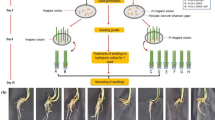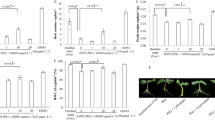Abstract
Excised wheat (Triticum aestivum L.) and field pea (Pisum arvense L.) roots, incubated under anaerobic conditions or in the presence of uncouplers of oxidative phosphorylation [2,4-dinitrophenol (DNP), carbonylcyanide-m-chlorophenylhydrazone, pentachlorophenol] accumulated nitrite as a result of an inhibition of nitrite reduction. In isolated root plastids, nitrite reduction was dependent on a supply of glucose-6-phosphate (G6P) and did not require ATP. The estimated Km value for glucose 6-phosphate was 1.25 mM. Glucose and fructose-1,6-diphosphate were ineffective substrates for nitrate reduction. Anaerobic conditions and treatment with DNP, which would result in a cessation of ATP production by the mitochondria and a stimulation of glycolysis via the “Pasteur effect”, were shown to decrease the G6P content of excised roots of wheat and pea. A negative correlation was observed between the level of G6P and nitrite accumulation on root tissues. It is proposed that an interruption in the supply of G6P to the root plastid under these conditions would result in an inhibition of nitrite reduction leading to nitrite accumulation.
Similar content being viewed by others

Abbreviations
- G6P:
-
glucose-6-phosphate
References
Barker, J., Khan, A.A., Solomos, T. (1967) Studies in the respiratory and carbohydrate metabolism of plant tissues. New Phytol. 66, 577–596
Dalling, M.J., Tolbert, N.E., Hageman, R.H. (1972) Intracellular location of nitrate reductase and nitrite reductase. II. Wheat roots. Biochim. Biophys. Acta 283, 513–519
Dixon, W.L., ap Rees, T. (1980) Identification of the regulatory steps in glycolysis in potato tubers. Phytochemistry 19, 1297–1301
Emes, M.J., Fowler, M.W. (1979a) The intracellular location of the enzymes of nitrate assimilation in the apices of seedling pea roots. Planta 144, 249–253
Emes, M.J., Fowler, M.W. (1979b) Intracellular interactions between the pathways of carbohydrate oxidation and nitrate assimilation in plant roots. Planta 145, 287–292
Emes, M.J., Ashihara, H., Fowler, M.W. (1979) The influence of nitrate on particulate-6-phosphogluconate dehydrogenase activity in pea roots. FEBS Lett. 105, 370–372
Faiz-ur-rahman, A.T.M., Trewavas, A.J., Davies, D.D. (1974) The Pasteur effect in carrot root tissue. Planta 118, 195–210
Ferrari, T.E., Varner, J.E. (1971) Intact tissue assay for nitrite reductase in barley aleurone layers. Plant Physiol 47, 790–794
Heber, U. (1974) Metabolic exchange between chloroplasts and cytoplasm. Annu. Rev. Plant Physiol. 25, 393–421
Heldt, H.W., Rapley, L. (1970) Specific transport of inorganic phosphate, 3-phosphoglycerate and dihydroxyacetone phosphate, and of dicarboxylates across the inner membrane of spinach chloroplasts. FEBS Lett. 10, 143–148
Hewitt, E.J., Nicholas, D.J.D. (1964) Enzymes of inorganic nitrogen metabolism. In: Modern methods of plant analysis, Vol. 7, pp. 67–172, Linskens, H.F., Sanwal, B.D., Tracey, M.V. eds. Springer, Berlin
Hoagland, D.R., Arnon, D.I. (1950) The water-culture method for growing plants without soil. California Agric. Exp. Stat. No. 347
Kelley, G.J., Turner, J.F. (1969) The regulation of pea seed phosphofructokinase by phosphoenolpyruvate. Biochem. J. 115, 481–487
Krebs, H.A. (1972) The Pasteur effect and the relations between respiration and fermentation. Essays Biochem. 8, 1–34
Kumada, H. (1953) The nitrate utilization in seed embryos of Vigna sesquipedalis. J. Biochem. 40, 439–450
Lee, R.B. (1979) The release of nitrite from barley roots in response to metabolic inhibitors, uncoupling agents and anoxia. J. Exp. Bot. 30, 119–133
Miflin, B.J. (1974) The location of nitrite reductase and other enzymes related to amino acid biosynthesis in the plastids of roots and leaves. Plant Physiol. 54, 550–555
Nance, J.F. (1950) Inhibition of nitrate assimilation in excised wheat roots by various respiratory poisons. Plant Physiol. 25, 722–735
Solomos, T., Laties, G. (1975) The mechanism of ethylene and cyanide action in triggering the rise in respiration in potato tubers. Plant Physiol. 55, 73–78
Stepan-Sarkissian, G., Fowler, M.W. (1978) Changes in the levels of metabolites of the pathways of carbohydrate metabolism during the induction of nitrate assimilation in pea roots. Biochem. Physiol. Pflanzen 172, 1–13
Author information
Authors and Affiliations
Rights and permissions
About this article
Cite this article
Dry, I., Wallace, W. & Nicholas, D.J.D. Role of ATP in nitrite reduction in roots of wheat and pea. Planta 152, 234–238 (1981). https://doi.org/10.1007/BF00385149
Received:
Accepted:
Issue Date:
DOI: https://doi.org/10.1007/BF00385149



